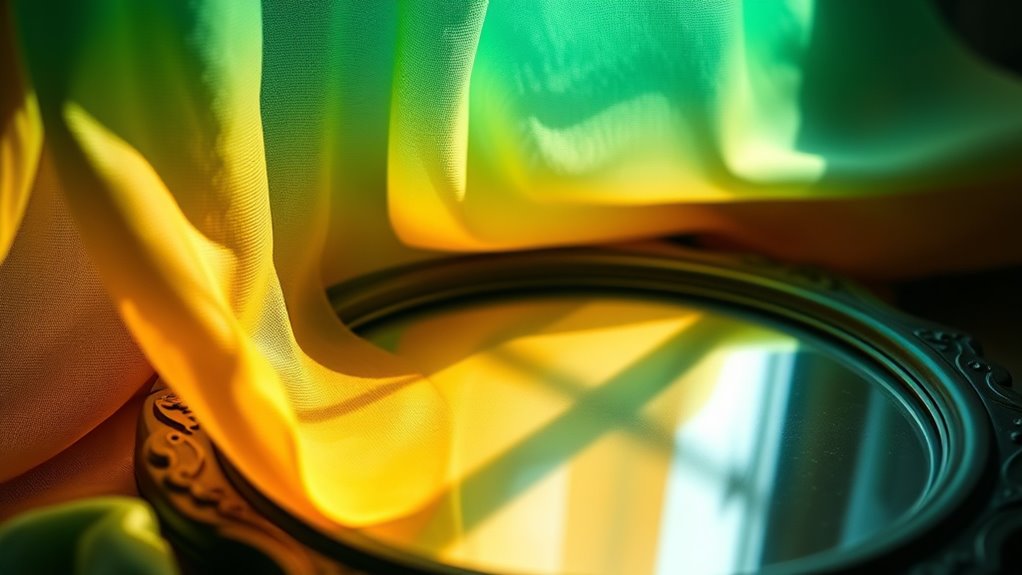Colors in your dreams hold deep symbolic meaning influenced by your culture, personal experiences, and emotions. For example, red may mean passion or danger, while blue signifies calmness. These hues shape how you interpret subconscious messages and themes within your dreams. Recognizing how your beliefs and feelings impact these symbols helps reveal hidden insights. If you keep exploring, you’ll discover even more about how hue influences your dream world.
Key Takeaways
- Colors in dreams carry cultural, personal, and societal meanings that influence symbol interpretation.
- The emotional tone associated with specific hues deepens understanding of subconscious messages.
- Bright or vivid colors like yellow can represent happiness or caution, depending on context.
- Personal experiences shape how individuals perceive and respond to dream colors.
- Recognizing hue nuances enhances self-awareness and reveals hidden psychological insights.

Colors and dream symbols often serve as powerful tools for understanding our subconscious mind. When you dream, the hues you see aren’t just random shades; they carry meaning shaped by cultural interpretations and psychological associations. These factors influence how your mind processes emotions, memories, and experiences while you sleep. For example, a red dream scene might evoke feelings of passion or anger, depending on your cultural background. In some cultures, red symbolizes luck and vitality, while in others, it signals danger or warning. Recognizing these cultural nuances helps you interpret your dreams more accurately, revealing insights about your inner world. Additionally, the recent growth of AI-driven security systems highlights how technology is increasingly involved in safeguarding our digital and personal spaces, which can also influence the themes we encounter in our dreams.
Colors in dreams reveal subconscious truths shaped by culture and personal associations.
Psychological associations also play an essential role in how color influences your dream symbols. Your personal experiences with specific colors can color (pun intended) the way you perceive and interpret them in your dreams. If you associate blue with calmness because of peaceful memories, dreaming of blue might encourage feelings of serenity or stability. Conversely, if green reminds you of envy or jealousy, seeing it in a dream could signify underlying insecurities. These associations are deeply individual but also shaped by broader societal influences, which create shared meanings around certain colors. Understanding this interplay between personal and cultural influences allows you to decode your dreams more effectively.
Color’s impact on dream symbolism extends beyond simple emotional reactions. It can alter the narrative of your dreams, emphasizing certain themes or feelings. For instance, bright yellow might symbolize happiness and optimism due to its sunny connotations, but in some contexts, it can also suggest caution or deceit. Dreaming of yellow could, thus, point to optimism or alert you to hidden doubts. The tone and context of the dream matter just as much as the color itself. When you analyze your dreams, consider not only the hue but also what’s happening around it. Are you feeling hopeful, anxious, or conflicted? The color’s psychological associations can guide you toward a deeper understanding of your subconscious messages.
Ultimately, recognizing how color influences dream symbols allows you to tap into a richer, more nuanced interpretation of your dreams. By considering cultural interpretations and psychological associations, you can uncover hidden truths about your emotional state and personal growth. Colors aren’t just visual impressions—they’re gateways into your inner psyche, revealing what might be difficult to articulate consciously. When you pay attention to the hues in your dreams, you’re engaging with your subconscious in a meaningful way, opening doors to self-awareness and healing that might otherwise remain closed.
Frequently Asked Questions
Can Color Preferences in Dreams Indicate Personality Traits?
You might wonder if your color preferences in dreams reveal personality traits. Color psychology suggests that the shades you choose can offer personality insights, reflecting your emotions and mindset. When you notice yourself drawn to certain hues in dreams, it could indicate underlying traits like creativity, calmness, or energy. Paying attention to these colors helps you understand yourself better, making your dreams a valuable tool for self-discovery.
Do Cultural Differences Influence Color Symbolism in Dreams?
Imagine your dreams as a tapestry woven with threads of cultural color meanings and cross-cultural symbolism. You’ll find that cultural differences influence these patterns, shaping how colors like red or white appear symbolically. These hues carry unique meanings across societies, making your dream’s color palette a reflection of cultural contexts. So, when interpreting your dreams, consider how cultural color symbolism influences the symbols you encounter, revealing deeper cultural insights.
How Do Recurring Colors in Dreams Relate to Emotional States?
Recurring colors in your dreams often mirror your emotional symbolism, revealing underlying feelings you might not realize. For instance, frequent red can indicate passion or anger, while blue might suggest calm or sadness. Color therapy suggests paying attention to these hues, as they reflect your emotional states. Recognize these patterns to better understand your inner emotions, using color symbolism as a tool for emotional insight and growth.
Is There Scientific Evidence Linking Color Perception to Dream Content?
Neuroscience studies and psychological experiments suggest that your perception of color can influence dream content. When you see certain hues before sleep, it may prime your subconscious, leading to dreams with specific themes or symbols. Although research is ongoing, evidence indicates that your brain processes colors during sleep, affecting your dreams. So, the colors you encounter daily or intentionally focus on might shape your dream experiences more than you realize.
Can Altering Bedroom Colors Impact Dream Themes or Vividness?
You can influence your dreams by changing your bedroom decor based on color psychology. Opt for calming hues like blue or lavender to promote more vivid and peaceful dreams, or choose warmer tones like red or orange to energize your sleep. Altering bedroom colors can subtly impact your dream themes and intensity, making your sleep environment a powerful tool for shaping your dream experience.
Conclusion
So, next time you dream of a specific hue, remember it might reveal more than you think. Studies show that about 12% of people report dreaming in color, which considerably influences their dream symbols. By paying attention to these hues, you can better understand your subconscious messages. Embrace the vibrant world of your dreams—those colors aren’t just visually stunning, they’re telling you something important about your inner feelings and thoughts.











